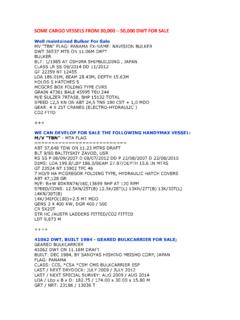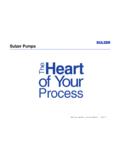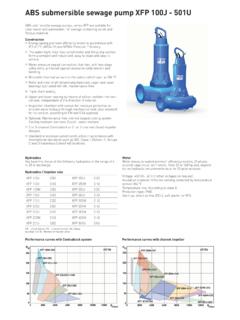Transcription of New Hybrid Process for Purification and Separation …
1 New Hybrid Process for Purification and Separation of MDI Isomers MANFRED STEPANSKI sulzer CHEMTECH Ltd. Industriestrasse 8 CH-9471 Buchs, Switzerland PETER FAESSLER sulzer CHEMTECH Pte. Ltd. 11 Tuas Avenue 18 Singapore 638895 ABSTRACT Based on proven and long-standing experience, sulzer has launched a new Hybrid Process which combines distillation and melt crystallization technology to manufacture pure monomeric MDI as well as any fraction of commercial interest. MDI from reaction is fed to the crude MDI distillation columns for Purification . The purified crude MDI is sent on to the isomers distillation column, where a mixture with high 2,4 -MDI content (typically 50 to 60 % 2,4 -MDI) and pre-concentrated dimer-free 4,4 -MDI are produced.
2 Following the distillation, pre-concentrated 4,4 -MDI is sent on to the melt crystallization section for final Purification . The residue from crystallization is recycled to the distillation column. Optionally, the residue can be further depleted of 4,4 -MDI, thus allowing any dimer-free 4,4 -MDI mixture from 50 to 80 % to be produced by melt crystallization. The flexibility of sulzer 's new Hybrid Process makes it possible to control and modify the properties of a broad range of MDI products. Heat integration and optimum combination of distillation and crystallization equipment allow the plant to be built at a lower investment cost and to be run at lower operating costs compared to current Purification technologies.
3 Due to the efficiency of the Separation train, this plant configuration is most attractive for new plants with more than 80 000 mtpy capacity. In existing plants, capacity can be expanded by adding one of the individual units to existing set-up. sulzer Chemtech is a world leader in mass transfer technology, and has developed extensive know-how in the Hybrid distillation and crystallization Process . The new Process can be licensed without limitation from sulzer and the products can be manufactured and sold worldwide without restriction. INTRODUCTION Methylene diphenyl diisocyanate (MDI) is manufactured from aniline by condensation with formaldehyde to produce methylene dianiline (MDA), which is in turn reacted with phosgene.
4 The reaction forms a mixture of monomeric MDI (mainly 4,4 -MDI with an isomeric 2,4 -MDI content) and components of higher molecular weight. The crude MDI mixture is distilled to remove the components of higher molecular weight and heavy and light boilers. Conventional processes use either distillation or melt crystallization to produce a pure 4,4 -MDI from the purified isomer mixture and most already rely upon sulzer distillation and crystallization technology. As a second product an isomer mixture with a high 2,4 -MDI concentration is produced. Both unit operations are well understood and give a good performance but they also have drawbacks.
5 Distillation consumes high amounts of energy and investment costs are usually high. Crystallization performs poorly with feed of high dimer content and the eutectic point of the solid-liquid equilibrium limits the recovery of 2,4 -MDI. NEW Hybrid Process The sulzer MDI Process is characterized by three Purification and Separation steps (Figure 1): 1. The crude MDI distillation unit to remove components of higher molecular weight. 2. The isomers distillation unit, where a product with a high 2,4 -MDI content and a pre-concentrated, dimer-free 4,4'-MDI are produced. 3. A static melt crystallization unit for final Purification of 4,4 -MDI.
6 Figure 1: Flow diagram of sulzer s new Hybrid MDI Process Crude MDI Distillation Unit Following the reaction, crude MDI is sent on to the crude MDI distillation column, where the Mono-MDI-Isomers and lights are separated from the MDI-oligomers and Poly -MDI. Key features of the crude MDI distillation column include: Advanced vacuum distillation technology using sulzer s structured high capacity packings MellapakPlus (Figure 2) and internals, resulting in excellent Separation efficiencies and Process advantages. The whole system is designed for very low pressure drop, resulting in high product yield and low degradation at moderate bottom temperature.
7 The use of specially developed, highly fouling- resistant liquid distributors for MDI distillation service secures highly reliable operation (Figure 3). Shut down periods of two years and more have been achieved. The whole system is developed and designed to minimize stagnant zones where products could be trapped over a long period. The direct condensation of the distilled MDI results in a short residence time and only brief high temperature exposure. If intermediate storage is required, the MDI can be cooled down directly to low temperature levels. Very low dimer contents are achievable.
8 Compact design avoids costly shell and tube condensers. Isomers Distillation Unit The isomers distillation unit consists of a fractionating column with 3 to 4 beds (depending on the lights concentration in the feed) of high efficiency structured packing. The design criterion for the whole system is low pressure drop and minimum residence time. The light boilers are withdrawn as top product, while the 2,4 - and the 4,4 -MDI are taken as side draws. The 4,4 -MDI is withdrawn in the vapor phase, condensed and directly cooled to less than 50 C in a side condenser/sub-cooler.
9 The bottom product consists of a mixture of 4,4 -MDI and oligomeric MDI. Specially designed falling film evaporators are used as reboilers. Compared to a single distillation system, where the 4,4 -MDI is distilled up to a purity of more than 99 %, the throughput with the Hybrid system is practically doubled. Consequently the residence time is halved, reducing the formation of polymers and increasing the yield of pure 4,4 -MDI. In a Hybrid system the isomers distillation unit is only about half as large as a single distillation unit. For large processing units ( 160 000 tpy) only one distillation unit is required, instead of two.
10 As the 4,4 -MDI concentration going to crystallization unit is only approx. 96 %, the reflux ratio is much lower. The energy consumption is reduced to approx. 52-60 % (exact figure depends on the recycle stream flow rate back from the crystallization unit). In the future high capacity wire gauze packing will further reduce the column dimensions for newly built distillation units. This packing will exhibit Crude MDI Distillation Unit Isomers Distillation Unit 4,4 -MDI Crystallization Unit Residue Processing 4,4 -MDI + 99 % 2,4 -MDI > 60 % 4,4 -MDI > 95 % Lights Recycle Recycle 4,4 -MDI ~80 % 4,4 -MDI 50 to 80 % Residue Residue Figure 2: Two layer interface of Mellapak segments (left) and new MellapakPlus (right) even lower pressure drop than the well known industrially widely used sulzer BX, and will provide new possibilities to debottleneck existing distillation units.








